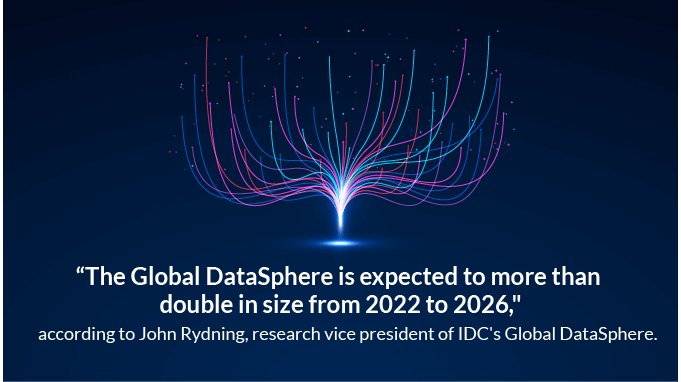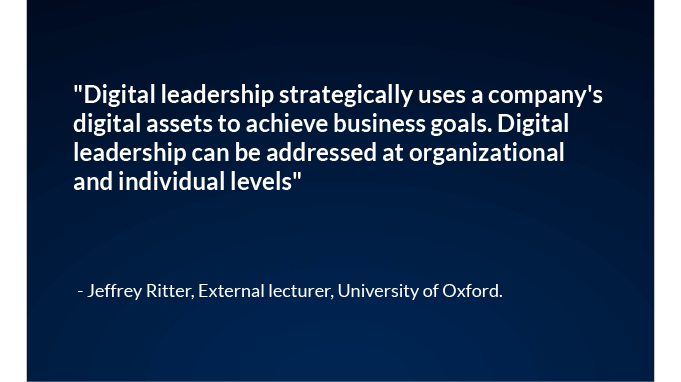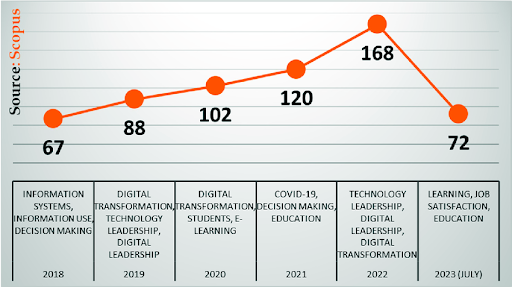Digital Leadership: Skills and Simple Tips for Success
In the rapidly evolving landscape of the digital age, the essence of leadership transcends traditional hierarchies.
Digital leadership, characterized by its adaptability and responsiveness to technological shifts, revolutionizes how we perceive and enact leadership.
Today's reality calls for a different type of leadership. One that guides teams with vision but also relates to them as human beings who crave purpose.
In this blog, I'll dig into how technology changes expectations and highlights role models across various fields.
The goal is to inspire and equip anyone to unlock their leadership potential. Let's reimagine leading in ways fit for this exhilarating digital era.
Let's Dive in!!

This rapid digitization of business is forcing a major evolution in leadership skills. With technology now ingrained into nearly every facet of operations and customer engagement, leveraging digital capabilities has become imperative for organizational success. Leaders must steer companies through regular disruption from innovations like artificial intelligence, expanded connectivity, data analytics, and more.
Did You Know? As per a Dell-IDC report IDC's Global DataSphere, which forecasts the amount of data that will be created on an annual basis, predicts that over the next five years, data will grow at a compound annual growth rate (CAGR) of 21.2% to reach more than 221,000 exabytes (an exabyte is 1,000 petabytes) by 2026.
Over the last 10-15 years, the ascent of digital leadership has matched the dynamic trajectory of technological advancements. Social media platforms gained massive popularity in this period, with over 4.95 billion users recorded in 2023. Big data analytics witnessed exponential growth, and AI has become integral to operational efficiency and strategic planning.
With more people seeking information online, businesses need to engage with their customers. To significantly enhance your business, prioritizing digital leadership is crucial!
The future depends on digitally smart leadership. Companies must make their leaders fluent in using technology, or they will be left behind.

What is Digital Leadership?
Digital leadership means guiding and directing teams or groups in a way that understands and uses technology well.
Various leadership styles,such as e-leadership, virtual leadership, technology leadership, and leadership 4.0, have similar meanings and can be used interchangeably.
Digital leadership involves using digital tools and understanding how they impact people to achieve goals effectively in today's tech-heavy world.

And what do digital leaders do?
For one, have a strong vision and strategy for digital transformation.
They understand new technologies like artificial intelligence, big data analytics, the Internet of Things, etc., and how to leverage them for innovation and growth.
Digital leaders focus on transforming company culture and employee skillsets for the digital-first world.
They promote agility, collaboration, and continuous learning so organizations can keep pace with the speed of change.
Digitally savvy leaders make data-based decisions and continuously learn new skills. The focus is leveraging digital to create great customer and employee experiences.
They prioritize using digital capabilities to deliver meaningful customer and employee experiences.
Evolution
Now that we understand the basics let us glimpse at the evolution of digital leadership over the years.
During the 2000s, the adoption of Web 2.0, social media, and mobile technology began enabling new ways for customer engagement and operational strategies. Leaders found themselves needing to acquire technological proficiency quickly.
The subsequent rise in smart devices, AI, automation, and data analytics throughout the 2010s increased the demand for leaders to plan how technology could change and transform their organizational landscapes.
Please refer to the infographic below to better understand how the digital transformation has occurred over the past five to six years.

Today, Digital transformation has changed how businesses operate, utilizing digital technologies to enhance efficiency, customer experiences, and overall competitiveness.
At its core, digital transformation is a strategic overhaul beyond implementing new technologies; it involves rethinking and redesigning business processes, models, and customer interactions.
Why does digital leadership matter?

Business Transformation
According to a report byMarketsandMarkets Only about 30% of companies navigate a digital transformation successfully. The global Digital Transformation Market size is to grow from USD 695.5 billion in 2023 to USD 3,144.9 billion by 2030 at a Compound Annual Growth Rate (CAGR) of 24.1% during the forecast period.
With more people seeking information online, businesses need to engage with their customers. To significantly enhance your business, prioritizing digital leadership is crucial!
Digitization has made it essential for businesses and operations to reinvent themselves continuously. For example, companies like Adobe have adopted subscription models enabled by software-as-a-service to change revenue streams.
Retailers are utilizing automation and AI - from warehouse robots to customized recommendations - to boost efficiency.Some retailers are also incorporating 3PL services to enhance their supply chain management and streamline logistics operations.
Media organizations now rely heavily on analyzing viewer data to inform content.
Flexible work arrangements allowing remote collaboration have gone mainstream due to digital connectivity.
In manufacturing, sensors and supply chain analytics guide just-in-time production powered by real-time data.
Technology integration and information networks enable more agility, personalization, and innovation across sectors and functions.
As digital capabilities advance, organizational boundaries and constraints will become less restrictive.
Digital Leadership in Action: Case Studies of Leading Companies

Digital disruptors like Uber, Ola, and Airbnb, born in the cloud, are transforming business models.
Uber has disrupted the traditional taxi business model by introducing a peer-to-peer ridesharing platform. By leveraging a mobile app, GPS technology, and a decentralized network of drivers, Uber offers a more convenient and flexible alternative to traditional taxi services, transforming the transportation industry.
Airbnb: Airbnb has transformed the hospitality industry by providing a platform for individuals to rent out their homes or rooms to travelers, challenging the traditional hotel business model.
When it comes to consumer behavior, E-commerce adoption is the game changer. The rise of online shopping platforms such as Amazon has shifted consumer behavior from traditional brick-and-mortar retail to digital shopping experiences.
Instagram & TikTok, Social media influence is showing new developments with each passing day. Platforms like Instagram and TikTok have transformed how consumers discover and engage with products, relying on influencers and social media for product recommendations and reviews.
Driving Innovation
Successful digital leaders create innovation and revenue growth in several key ways. With their strategic vision and a deep understanding of emerging technologies, they cultivate an environment where creativity flourishes.
Let us now take a quick peek into some of the revolutionary leaders who have embraced digital leadership and drive transformative change within their organizations.
According to Gartner, 91% of businesses are engaged in some form of digital initiative, and 87% of senior business leaders say digitalization is a priority. 89% of all companies have already adopted a digital-first business strategy or plan to do so.
Organizations rely on digital leaders to maintain agility despite ongoing technological shifts.
With 85% of executives recognizing digital transformation as a key priority, leaders guide their teams in adopting new technologies efficiently.
By fostering a culture of innovation, digital leaders ensure organizations can swiftly navigate the ever-changing tech landscape, positioning them for sustained success in the digital age.
Twenty-three of the top 30 Fortune 500 companies are digital-focused. The top global businesses have completely embraced digital practices.
For example, companies like Amazon, under the leadership of Jeff Bezos, have consistently embraced innovation, from introducing e-readers to pioneering drone delivery services. Digital leaders also leverage data analytics to uncover insights and identify opportunities for optimization.
Alphabet Inc., Google's parent company, led by Sundar Pichai, utilizes vast amounts of data to enhance its advertising services and develop new products.
Encouraging collaboration and cross-functional communication is another hallmark of effective digital leadership.
With leaders like the late Steve Jobs and Tim Cook, Apple is known for its seamless integration of hardware and software innovations, resulting in iconic products that drive substantial revenue growth.
Reed Hastings, Co-Founder & CEO of Netflix, transformed Netflix from a DVD rental service to a streaming giant. This is done by fueling growth through a strong digital platform and data-driven recommendations.
Similarly, Daniel Ek, Co-Founder & CEO of Spotify, created a revolutionary digital music streaming experience. It was powered by a data platform, machine learning, and a freemium model to turn the traditional music industry on its head.
By taking such an adaptive approach rather than relying upon stringent, long-term plans, they can tap into new opportunities and revenue streams.
Organizational Resilience
Organizations rely on digital leaders to maintain agility despite ongoing technological shifts.
With 85% of executives recognizing digital transformation as a key priority, leaders guide their teams in adopting new technologies efficiently.
By fostering a culture of innovation, digital leaders ensure organizations can swiftly navigate the ever-changing tech landscape, positioning them for sustained success in the digital age.
Twenty-three of the top 30 Fortune 500 companies are digital-focused. The top global businesses have completely embraced digital practices.
Digital leaders help companies adapt quickly and focus on fast action rather than long, detailed planning.
They launch new ideas rapidly to see what works. They learn from customer feedback and make improvements.
They encourage teams across the company to work closely to share information while training their workers to keep up with new digital skills.
This prepares them to adjust as needed when new technologies come along.
All these measures help their organization become more flexible, reactive, and fast-moving to tackle any technological disruption.
It helps them take advantage of opportunities earlier than competitors.
That's how digital leaders develop an adaptive culture that allows the company to thrive amidst rapid technology shifts.
The mantra is speed, collaboration, and learning - not rigid planning.
Digital Leadership Challenges and Solutions

| Issue | Challenges | Solutions |
| Rapid Technology Change | Keeping up with the constant evolution of technology can be a significant challenge for digital leaders. | Keeping up with the constant evolution of technology can be a significant challenge for digital leaders. |
| Information and Data Overload | With abundant information and data available, digital leaders face the challenge of filtering through the noise to extract valuable insights. | Combatting information and data overload requires an investment in ongoing training programs. Leaders can ensure that their teams have the necessary skills to manage and analyze data effectively. This includes providing training on the use of data analytics tools and promoting a data-driven mindset within the organization. Regular training sessions keep employees updated on the latest techniques and best practices in handling information. |
| Ethical Concerns Around Privacy and AI | With the rise in the adoption of artificial intelligence and data-driven technologies, digital leaders must navigate complex ethical considerations. | Addressing ethical concerns around privacy and AI involves creating feedback loops for constant evaluation. Leaders should encourage open communication channels where employees can voice concerns and report ethical issues. |
| Managing Remote/Hybrid Teams | The shift to remote and hybrid work models poses challenges for digital leaders regarding team collaboration, communication, and maintaining a cohesive company culture. | Use digital collaboration/communication tools like Slack, Asana, and Zoom to align and connect with remote teams. However, nothing can beat the impact of an in-person meeting, so don’t do away with physical meetings |
| Communication Barriers with Digital Tools | While digital tools enhance communication, they also introduce challenges such as misinterpretation, information overload, and the lack of non-verbal cues | Use visuals and summaries to synthesize complex data for colleagues. Make it accessible. |
Key Skills and Knowledge for Digital Leaders

Digital Leaders need a diverse set of competencies and skills. These include,
- digital transformations
- fostering innovation
- building digital capabilities
- forming strong relationships
- possessing emotional intelligence
- being adaptable
- maintaining a growth mindset
- quick learning
- willingness to experiment
10.effectively leading change
A study by PwC revealed that 80% of executives consider collaboration skills crucial for digital leaders. Digital transformation leaders need to break down silos and build cross-functional teams to drive innovation and successful digital transformation initiatives within the organization.
Statistics: 83%, of digitally mature organizations strongly agree that data-driven decision-making is essential for success.
Let us look in detail at the must-have skills for digital leadership.
1. Soft Skills
-
Visionary Thinking - With fast-changing technologies, leaders must be able to envision digital possibilities for new products, processes, and models that move the organization forward. They set an inspirational direction for tech adoption.
-
Empathy - Leaders need soft skills to motivate people through a chaotic digital disruption and upskilling demands. Showing empathy, listening, and connecting on a human level is crucial when change creates uncertainty.
-
Communication - Communicating transformation roadmaps and new operational blueprints is imperative in rallying employee mindshare. Leaders must be able to convince stakeholders why "going digital" is necessary through compelling storytelling.
-
Agility - Rigid plans fail in dynamic digital environments with constant software updates and shifting customer behaviors. Leaders must dynamically assemble cross-functional teams to move ahead. A more decentralized approach and forgoing hierarchical decisions can be winners.
Visionary, empathetic, and agile leadership unites technologists, creatives, operators, and partners behind a movement greater than any individual contribution. Great digital achievement starts with great leadership that moves hearts and minds.
2. Technical Proficiency
As companies transform digitally, leaders must develop a deeper understanding across three emerging domains - data analytics, cybersecurity, and frontier technologies like AI and blockchain.
-
Data literacy: Robust data literacy is imperative as insights from customer analytics, market research, and operational data shape decisions.
-
Building mathematical fluency: It aids in grasping machine learning concepts that drive personalization, process automation, and forecast modeling. Hands-on data analysis also informs investments.
-
Cybersecurity: This can no longer be left solely to tech teams. As products and internal systems become software-defined, security considerations must enter discussions on digital capabilities. Appreciating vulnerabilities across networks, devices, and data communication enables weighing cyber risks against functionality gains. Robust cybersecurity practices safeguard the integrity of data-driven processes.
-
Data analytics: Leveraging data analytics helps enhance the effectiveness of AI applications
-
Blockchain: With its decentralized and tamper-resistant nature, blockchain adds more trust to digital transactions. So, a comprehensive understanding of these elements empowers digital leaders to navigate the complexities of the digital landscape with confidence.
All these competencies are interconnected and form the bedrock of successful digital transformation.
3. Strategic Insight
The importance of anticipating digital trends and disruption cannot be emphasized enough in the ever-evolving landscape of the digital age.
Anticipating digital trends enables leaders to stay ahead of the curve, positioning their organizations to leverage new opportunities and navigate potential challenges.
Failure to anticipate disruptive technological changes can lead to obsolescence and hinder a company's competitiveness.
Let us understand this better with the help of an example.
E-commerce platforms like Amazon and eBay foresaw the growing preference for online shopping and invested in user-friendly interfaces, seamless payment systems, and personalized recommendations. Doing this significantly enhances digital CX in B2B and B2C and contributes to a seamless shopping experience for both businesses and consumers alike.
These companies adapted to consumer behavior and stayed ahead of the digital curve, experiencing significant growth as a result.
In essence, staying attuned to digital trends is not merely a strategic advantage but a fundamental necessity for sustained relevance and prosperity in the digital era.
Tips for Developing Digital Leadership

Growth Mindset
When things evolve quickly, like new technologies or ways of doing things, an adaptive mindset becomes necessary.
It helps leaders see the changes happening at this unreal pace not as problems but as exciting opportunities to learn and improve.
Instead of seeing failures as roadblocks, digital leaders with a growth mindset see them as stepping stones toward improvement.
This mindset fuels a passion for continuous learning, encourages experimentation with new ideas, and fosters resilience in the face of evolving digital complexities.
Digital leaders embracing a growth mindset become not just navigators of change but enthusiastic learners, inspiring their teams to embrace challenges, adapt to new technologies, and strive for continuous improvement in the ever-evolving digital world.
Here are some practical tips for Digital Upskilling
- Explore Online Courses:
Take advantage of online platforms like Codecademy or Google Digital Garage that offer beginner-friendly courses on various digital skills.
- Practice with Real Projects:
Apply what you learn by working on simple projects. Build a personal website, create a blog, or try your hand at basic coding exercises to reinforce your skills.
Join digital coaching groups. Peer communities focused on digital leadership development provide support, structured programs, and accountability to apply learnings. Share experiences navigating capability-building journeys.
- Join Webinars and Virtual Talks:
Attend webinars and virtual events related to your interests. Many are free and provide valuable insights from experts in the field.
- Ask for Guidance and Feedback:
Seek advice from peers or professionals in your network. Join digital coaching groups. Peer communities focused on digital leadership development provide support, structured programs, and accountability to apply learnings.
Regularly assess the effectiveness of digital strategies, learn from successes and failures, and adapt approaches based on evolving business and technology landscapes.
- Mentorship and Knowledge Sharing:
Foster a culture of mentorship and knowledge sharing. Encourage leaders to mentor and be mentored, creating a collaborative environment where insights and experiences related to digital leadership are exchanged.
- Cross-Functional Training:
Implement cross-functional training initiatives to broaden leaders' skill sets. Exposure to different areas of the organization enhances adaptability and promotes a holistic understanding of the business.
- Networking and Industry Engagement:
Encourage leaders to actively engage in industry events, conferences, and professional networks. Networking fosters exposure to diverse perspectives, industry best practices, and emerging technologies, contributing to continuous professional development.
- Incentivize Innovation:
Implement incentive programs that reward innovative thinking and experimentation. Recognizing and celebrating digital initiatives encourages leaders to proactively seek and implement innovative solutions within their areas of responsibility.
Keep in mind, the trick is to take small, steady steps and, most importantly, enjoy the learning process!
Digital Leadership’s impact on employee engagement

Digital leadership significantly impacts employee engagement by leveraging technology for transparent communication, collaborative work, and feedback.
Leaders who leverage digital tools for transparent communication, feedback mechanisms, and collaborative platforms create a more connected and engaged workforce.
The digital channels help make employees feel more directly involved in organizational goals .
Digital leadership also enables flexible work arrangements, supporting a healthier work-life balance.
Emphasizing continuous learning on digital platforms showcases leaders' commitment to team growth, further enhancing engagement. I
Overall, digital leadership helps transform the workplace, making it dynamic, inclusive, and aligned with the expectations of the modern workforce.
The Future of Digital Leadership

Emerging Technology Trends
As we approach 2024, digital leaders are gearing up for some key trends shaped by rapidly evolving technologies. The upcoming year promises a multitude of trends that will significantly influence the strategies and approaches of these leaders.
Let's take a look at how the digital leaders will be influenced by the fast changing technologies and different ways of doing things.
Artificial Intelligence and Automation Integration: In 2024, digital leaders will focus on seamlessly integrating artificial intelligence and automation into their operations, enhancing efficiency and productivity.
Sustainable and Ethical Tech Practices: With the Climate crisis looming, there will be a growing emphasis on sustainable and ethical technology practices, with digital leaders prioritizing environmentally friendly solutions and ethical considerations in decision-making.
Convergence of Data Analytics, Cybersecurity, and Immersive Technologies: The merging of data analytics, robust cybersecurity measures, and immersive technologies will redefine how organizations operate in the digital space, requiring digital leaders to navigate this integrated landscape adeptly.
Hybrid Work Model Adoption: Digital leaders in 2024 will champion the widespread adoption of hybrid work models, leveraging technology to facilitate seamless collaboration between remote and in-office teams, fostering flexibility and work-life balance.
Emphasis on Upskilling: Recognizing the importance of continuous learning, digital leaders will place a strong emphasis on upskilling initiatives, ensuring that their teams acquire the necessary digital competencies to navigate evolving technologies and stay competitive in the digital landscape.
Preparing for the Future
To be future-ready, leaders must proactively prepare for the challenges and opportunities.
Continuous learning is paramount; leaders should invest in staying informed about the latest technological advancements and industry trends.
Developing a robust digital strategy that aligns with the organization's goals is crucial for sustained success.
Cultivating a culture of agility and adaptability ensures that leaders and their teams can navigate the ever-changing digital landscape.
Collaboration and partnerships with technology experts and innovators can provide valuable insights and foster innovation within the organization.
Fostering diversity and inclusion in leadership teams also ensures a broad range of perspectives to tackle complex digital challenges.
Ultimately, leaders must be proactive in equipping themselves and their organizations for the dynamic future of digital leadership.
Implementing Digital Leadership
Leaders can implement digital leadership by prioritizing a tech-savvy mindset within their teams. Here are some key steps and principles to implement digital leadership:
- Develop a clear digital strategy aligned with organizational goals. Embrace agile methodologies to respond quickly to market changes.
- Invest in the necessary technology infrastructure, ensure teams are digitally aware, and encourage collaboration across departments.
Lead by example in using technology for decision-making and consistently communicate the benefits of digital transformation to the entire organization. - Embrace a continuous learning approach, regularly evaluating and adjusting strategies to stay ahead in the ever-evolving digital landscape.
- Encourage leaders and teams to make decisions based on data analytics. Prioritize cybersecurity measures to protect digital assets.
Conclusion
Mastering the art of digital leadership is more crucial than ever in our rapidly evolving world. The skills required to lead in the digital age are diverse, encompassing adaptability, tech-savviness, and a strategic mindset.
Successful digital leaders must embrace change and foster a culture of innovation within their teams.
As we continue our journey into the digital age, let these skills and tips serve as beacons guiding us toward effective and impactful digital leadership.
The future is digital, and with the right skills and mindset, we can thrive in the exciting challenges.

















